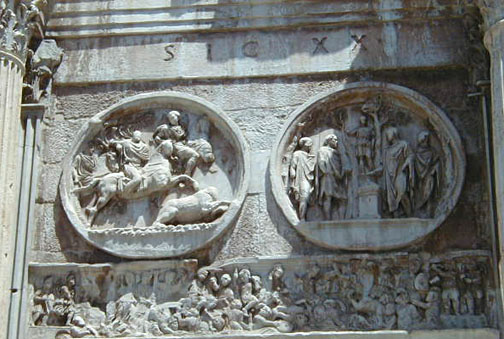The Arch of Constantine
circa 300 CE
Early Christian
Marble
Monument commemorating Constantine's defeat of Mazentius
--The great triple-passageway arch was erected in Rome between 312 and 315 CE. Much of the sculptural decoration and the columns of the arch were reclaimed from some of the earlier monuments of Trajan, Hadrian, and Marcus Aurelius. The heads of the emperors in these reliefs were re-cut to resemble the new ruler. These reused sculptures were carefully selected to associate Constantine with the "good emperors". In one of the Constantinian reliefs above the arch's lateral passageways, Constantine is shown on the platform in the Roman Forum, flanked on either side by representations of Marcus Aurelius and Hadrian. This recycling of earlier works is often used as evidence of a decline in technical skill and creativity in the latter part of the pagan Roman Empire. However, the friezes of this archway mark a distinctive shift towards the iconic art of the Middle Ages. The art of the Roman Empire was focused on portraying an idealized, perfected version of its subject whereas Early Christian art sought to teach and tell stories in a way that was immediately accessible to all.

(Arch of Constantine)

(Detail of roundel frieze)
2 comments:
studying christian architecture, are we?
Yeah, we just got through the Early Christian period and are working into the "dark ages" here pretty soon. It's interesting stuff, definitely better than late Roman Empire...Oh, ANOTHER statue of the Emperor? AWESOME. At least the Early Christian stuff has some weird stuff happening and LOTS of symbols to pick apart.
Post a Comment